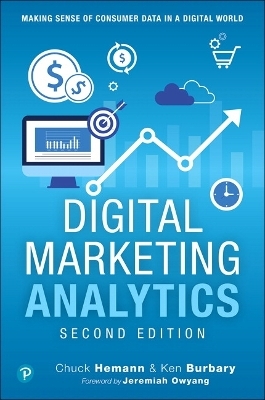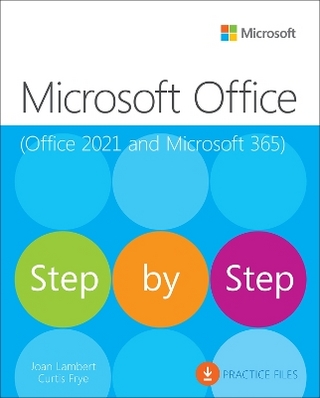
Digital Marketing Analytics
Que Corporation (Verlag)
978-0-7897-5960-3 (ISBN)
Why hasn’t all that data delivered a whopping competitive advantage? Because you’ve barely begun to use it, that’s why! Good news: neither have your competitors. It’s hard! But digital marketing analytics is 100% doable, it offers colossal opportunities, and all of the data is accessible to you.
Chuck Hemann and Ken Burbary will help you chop the problem down to size, solve every piece of the puzzle, and integrate a virtually frictionless system for moving from data to decision, action to results! Scope it out, pick your tools, learn to listen, get the metrics right, and then distill your digital data for maximum value for everything from R&D to customer service to social media marketing!
- Prioritize—because you can’t measure and analyze everything
- Use analysis to craft experiences that profoundly reflect each customer’s needs, expectations, and behaviors
- Measure real digital media ROI: sales, leads, and customer satisfaction
- Track the performance of all paid, earned, and owned digital channels
- Leverage digital data way beyond PR and marketing: for strategic planning, product development, and HR
- Start optimizing digital content in real time
- Implement advanced tools, processes, and algorithms for accurately measuring influence
- Make the most of surveys, focus groups, and offline research synergies
- Focus new marketing investments where they’ll deliver the most value
- Identify and understand your most important audiences across the digital ecosystem
Chuck Hemann, Managing Director of Analytics/Head of Digital Analytics for W2O, has spent the past 14 years providing strategic counsel on digital analytics, measurement, online reputation, and social media. He was previously Global Director of Digital and Paid Media Analytics at Intel Corporation. He has worked with global brands from Intel to P&G to Verizon. Ken Burbary, Consultant and Digital Marketing Professor at Cornell Johnson Graduate School of Management, has 20+ years of online marketing and advertising experience, including a deep background in digital and social media. He served as VP - Group Director, Strategy and Analysis at Digitas, working with global brands from American Express and Bank of America to P&G and GM.
Foreword xiv
Chapter 1 Understanding the Synergetic Digital Ecosystem 1
The Evolution of the Digital Ecosystem 2
Data Growth Trends 3
Digital Media Types 4
Paid Media 6
Owned Media 9
Competitive Intelligence 10
Clickstream (Web Analytics) 11
Conversion Analytics 12
Custom Segmentation 13
Visual Overlays 13
Social Media Reporting 13
User Experience Feedback 15
Real-Time Site Analytics 15
Chapter 2 Understanding Digital Analytics Concepts 17
Starting at the Top 18
Applying a Measurement Framework 19
Determining Your Owned and Earned Social Metrics 20
Demystifying Web Data 32
Digital Advertising Concepts 34
Searching for the Right Metrics 35
Paid Search 36
Organic Searches 37
Aligning Digital and Traditional Analytics 38
Primary Research 39
Traditional Media Monitoring 40
Traditional CRM Data 40
Bringing It All Together 41
The Reporting Timeline 41
The Reporting Template 41
Chapter 3 Choosing Your Analytics Tools 43
Evaluating New Marketing Technologies 44
Organizing Your Marketing Technology Stack 47
Cisco’s Marketing Technology Stack 48
Intel’s Marketing Technology Stack 49
Identifying Critical Marketing Technology Solutions 51
Who Decides Which Tool to Buy? 54
Achieving Adoption of Marketing Technology Solutions 54
Chapter 4 Digital Analysis: Brand 59
Benefits of Digital Brand Analysis 60
Brand Analysis in the Digital Age 61
Brand Share 62
Brand Audience 68
Brand and Consumer Alignment 71
The Future of Digital Brand Analysis 73
Chapter 5 Digital Analysis: Audience 75
What Is Audience Analysis? 78
Audience Analysis Use Cases 80
Digital Strategy Development 80
Content Strategy Development 81
Engagement Strategy 81
Search Engine Optimization 82
Content Optimization 82
User Experience Design 82
Audience Segmentation 83
Audience Analysis Tool Types 83
Additional Audience Analysis Techniques 89
Conversation Typing 90
Event Triggers 92
Chapter 6 Digital Analysis: Ecosystem 93
Ecosystem Analysis 94
Ecosystem Analysis Outputs 97
Digital Ecosystem Maps 98
Chapter 7 Return on Investment 99
Defining ROI 100
Return on Engagement (ROE) 101
Return on Influence 102
Return on Experience 104
Properly Tracking ROI 105
Understanding the Top-Down Revenue Measurement Approaches 106
Utilizing Bottom-Up Measurement Models 108
Three-Tiered Approach to Measuring Digital Marketing Effectiveness 112
Chapter 8 Understanding Digital Influence 115
Understanding the Reality of Digital Influence 117
The “Tipping Point” Phenomenon 117
The Community Rules Phenomenon 118
Developing a Modern-Day Media List 119
Using the Tools of the Trade 121
Klout 122
Other Important Influencer Analysis Tools 124
Developing Your Own Influence Approach 126
Online Versus Offline Influence 127
Using the Influencer List 128
Chapter 9 How to Use Digital Analytics to Inform Marketing Programs 131
Understanding the Social Media Landscape Analysis 133
Search and Owned Analysis 139
Conducting Media Analysis 141
Chapter 10 Improving Customer Service 145
Customer Expectations 146
The Social Customer Service Conflict 148
Understanding the Customer 151
Understanding Customer Intent 152
Personalizing the Customer Experience 152
Social Customer Service Models 153
The Ad Hoc Stage of Customer Service 153
The Limited Stage of Customer Service 153
The Formal Stage of Customer Service 153
Delta Air Lines 154
Chapter 11 Using Digital Analytics to Anticipate a Crisis 157
Developing a Modern-Day Issues Management Plan 158
Identifying Known Issues 160
Listing the Known Issues 160
Knowing the Share of Conversation Online 161
Profiling Pro and Con Influencers 163
Briefing and Getting to Know the Influencers 163
Placing the Right Content 163
Knowing the Positive and Negative Words 164
Tagging the Right Words 165
Crisis Day Monitoring and Ongoing Reporting 166
Dealing with the Issue Hitting 166
Developing Your Content Plan 167
Developing Your Reporting Plan and Reporting Cadence 168
Reporting Frequency and Contents During a Crisis 169
Reporting Frequency and Contents After a Crisis 169
Correcting the History After a Crisis Is Over 171
Evaluating Your Preliminary Research 171
Identifying Key Third Parties and a Content Syndication Plan 172
Chapter 12 Launching a New Product 173
General Overview of the Product Lifecycle 174
The Product Lifecycle Introduction Phase 176
What Is the Consumer Reaction to Product X? 178
What Are the Consumer Concerns About Product X? 179
What Are the Consumer’s Unmet or Unstated Needs? 179
The Product Lifecycle Growth Phase 180
What Are the Communities, Sites, and Social Platforms in Which Product X Is Being Discussed, Shared, and Evaluated? 181
Who Are the Influencers in the Product X Conversation? 182
What Is the Consumer Reaction to Retail or Promotions for Product X? 183
The Product Lifecycle Maturity Phase 184
What Consumer Trends and Preferences Have Emerged Around Product X Use? 186
What Related Products Do Consumers Show Interest In? 186
Chapter 13 Building Your Research Plan 189
Developing Your Source List 190
Identifying Data Sources 191
Picking the Channels for Analysis 193
Identifying Search and Source Languages 195
Nailing Down the Research Methods 196
Developing a Hypothesis 197
Time Frame for Analysis 199
Identifying the Project Team 200
Determining the Depth of Analysis 201
Building the Coding Framework 202
Taking a Sentiment Approach 203
Filtering Spam and Bots 204
Chapter 14 Building Reports that Will Actually Be Useful 207
Constructing Reports 208
Delivering a Report 215
Understanding Report Use Cases 216
The Executive-Level Use Case 217
The Management-Level Use Case 218
The Analyst-Level Use Case 219
Building a Central Repository of Information 220
Command Centers 221
Web-Based Applications 222
Chapter 15 The Future of Digital Data 223
Watching How the Digital Analytics Disciplines Evolve 225
Looking Back at How Social Media Listening Has Evolved 226
Diving into Search Analytics 228
Looking into the Audience Analysis Crystal Ball 228
Forecasting the Content Analysis of the Future 229
Understanding the Influencer Analysis Landscape 230
Understanding Where Digital Analytics Goes from Here 231
Bridging the Analytics Talent Gap 232
Housing Your Customer Data 234
Continuing Consolidation of Data Sources Just as New Sources of Data Emerge 235
Dealing with Growing Concerns About Consumer Privacy 236
Making Social Data Become More Available to Brands 237
Continuing Struggle by Companies to Get Clean and Accurate Data 237
Continuing Measurement Challenges for Chief Marketing Officers (CMOs) 238
Scratching the Surface of Machine Learning and Artificial Intelligence 238
Index 243
| Erscheinungsdatum | 12.06.2018 |
|---|---|
| Reihe/Serie | Que Biz-Tech |
| Verlagsort | Indianapolis |
| Sprache | englisch |
| Maße | 152 x 229 mm |
| Gewicht | 378 g |
| Einbandart | kartoniert |
| Themenwelt | Informatik ► Office Programme ► Office |
| Informatik ► Web / Internet ► Social Web | |
| Informatik ► Web / Internet ► Suchmaschinen / Web Analytics | |
| Wirtschaft ► Betriebswirtschaft / Management ► Marketing / Vertrieb | |
| Wirtschaft ► Betriebswirtschaft / Management ► Unternehmensführung / Management | |
| ISBN-10 | 0-7897-5960-8 / 0789759608 |
| ISBN-13 | 978-0-7897-5960-3 / 9780789759603 |
| Zustand | Neuware |
| Informationen gemäß Produktsicherheitsverordnung (GPSR) | |
| Haben Sie eine Frage zum Produkt? |
aus dem Bereich


